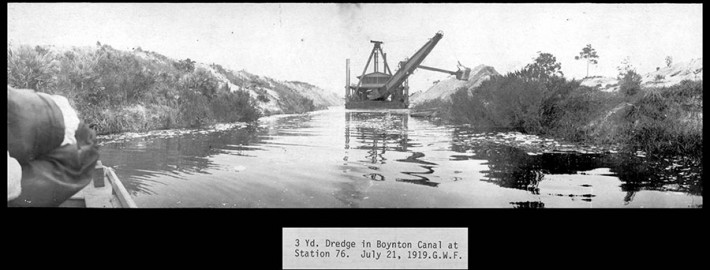The Orrin Randolph Plan
The Lake Worth Drainage District (LWDD) was established on June 15, 1915, with a three-member Board of Supervisors whose mission was to reclaim land within its boundaries. Prior to the creation of LWDD, a considerable amount of drainage work had already been completed by several entities such as the State of Florida, the Palm Beach Farms Land Company, the Model Land Company, and the Boston & Florida Atlantic Coast Land Company. In addition, private landowners and farmers had dredged drainage canals throughout the area. Although small drainage systems had been created, a cohesive long-term drainage plan was needed for the future expansion of what is now known as Palm Beach County.
In the spring of 1916, Orrin Randolph, Chief Engineer for the newly created LWDD, presented his first report to the Board of Supervisors. This report contained 127 pages detailing a plan of means and methods for draining the lands within the boundaries of LWDD. The report was submitted in compliance with Chapter 6458 of the 1913 Session Laws of the State of Florida. At that time, LWDD consisted of 129,317 acres of land and 3,400 acres of water. Rectangular in shape, LWDD extended 26 miles in length and 8 miles in width. Population records of 1916 showed there were approximately 6,500 owners of property within LWDD’s boundary making the average ownership equal to 20 acres per capita. Approximately 400 farmers were cultivating an estimated 5,000 acres of land, principally vegetables for distribution to northern markets.
In his report, Orrin Randolph identified the areas within LWDD that could not safely be relied upon for agricultural purposes and outlined the design parameters needed for future drainage. Randolph stated, “Provisions for artificial drainage would absolutely be necessary in order to provide a run-off rapid enough to prevent the destruction of crops as a result of accumulated excess water on the land.” Thus, Randolph’s extensive report was adopted by the Board of Supervisors as the Plan of Reclamation. The implementation of this plan would forever change the local landscape.
South Florida’s abundant agricultural resources served as the catalyst upon which prosperous and populous cities were built. This prosperity, then and now, is a result of the water management plan introduced by Orrin Randolph and adopted by LWDD over a century ago as the Plan of Reclamation. This plan created a large network of drainage canals providing flood control and water supply which remarkably still functions today for over 800,000 residents and tens of thousands of acres of farmland.
Agriculture in our area no longer exists to only feed the local inhabitants, and the migration of people into Florida continues to increase annually. LWDD has modified its mission over the century to meet the changing water management needs of these two diverse communities. Much of the District’s emphasis today is on residential flood protection. Although meeting the needs of agriculture and settlement can bring many challenges, it is because they harmoniously co-exist that living and working in our community is so highly desirable.




